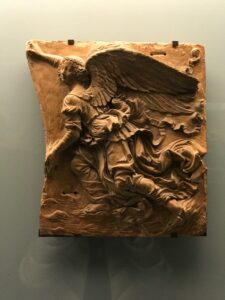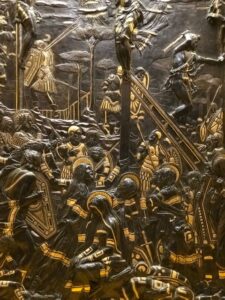Liviana Martin

Visiting the exhibition ‘The Body and the Soul’ at the Castello Sforzesco in Milan takes you on a journey through the history of Italian Renaissance sculpture between 1400 and 1500, a story that speaks not only of the body of man but also of the movements of the soul and of the emotions in a new and realistic way. From inert matter, the sculptors have brought to light statues able to communicate, through their skill, human sensations, to upset and excite us, as if they were really about to come to life.
The exhibition also uncovers the roots of this expressionism in classical art and in particular that of the ancient Roman world. The statues of the Roman emperors, or of wealthy personages of the time, who have come down to us, express solemnity and vivacity in their features, they speak to us of their inner life. The findings in the most important archaeological sites, from Rome to Pompeii and Herculaneum, to name but three of hundreds, allow us to reconstruct their whole vanished world.

terracotta con tracce di bronzatura
The discovery in 1500 near Rome of the sculptural group of Laocoön and his Sons (a Roman copy of a Greek original) will go on to influence entire generations of artists, both for the expression of pain associated with physical beauty and for the rendering of body movements . Laocoön, according to legend, was a priest of the god Apollo, attacked and killed together with his children by two sea snakes. The subject is a pretext for staging the bodies struggling in jumbled, dynamic, unstable movements. There is no longer the formal balance, perfected in previous sculpture, but a renewal of the aesthetic canons of the Greeks.
The most famous Renaissance artists influenced by these findings move from Donatello to Michelangelo. They draw inspiration from Roman sarcophagi and bas-reliefs, where the figures express contrasting feelings, which oscillate between the sense of fury and that of grace.
A little-known artist, Giovanfrancesco Rustici, in the Zuffa, two high-reliefs in terracotta, represents, in an exceptionally moving way, a scene of struggle in which men are reduced to the rank of animals and fight not with weapons but with bites. In this work one can hear the fury and almost the cries of battle. Grace, by contrast, is the characteristic of Verrocchio’s Angels in Flight, a terracotta from 1480, a masterpiece of Florentine art. Angels are ethereal creatures, almost moved by the wind, which ruffles the draperies of their garments, as they advance with supple and elegant movements. The reference to classical art can be found in the group of the Three Graces, Roman art of the second century after Christ, which represents the daughters of Zeus, a symbol of beauty, arts and fertility. They are naked girls who with their movements generate harmony in the intertwining of bodies in a kind of dance that is a union between external and internal beauty, through which the fullness of existence
can be reached. The subject influenced legions of artists, from the painting of Botticelli and Raphael, to the sculpture of Canova and Thorvaldsen, to the poetry of Foscolo.
The secular path of the exhibition alternates with the religious one. Even Renaissance sacred art aims to represent the motions of the soul through the expressiveness of the bodies, it wants to disturb and move the spectators and, as in a theatrical performance, it stages the drama of death and the deposition of the body from the cross, of Christ.
The greatest master of sacred art was Donatello: in the Crucifixion, a partially gilded bronze bas-relief, the artist shares the pain of Christ and the thieves crucified next to him, the weeping of the pious women at his feet , the indifference of the soldiers watching the scene. The gilding of the haloes, robes and armour illuminates a dark and heartbreaking composition, as well as accentuating the tragic nature of the event.

Bronze with gold and silver damascening,
Museo Nazionale del Bargello, Florence
In the mid-1400s, the Lamentations over the body of Christ, realistic reconstructions in painted wood or terracotta of the moment before the burial of the Messiah, spread to northern Italy. The magnificent figures of Mary Magdalene and St. John the Evangelist, in gilded and painted wood, the work of Angelo Del Maino, express feelings of pain in a dramatic and violent way, facilitating the imagination of the faithful and stimulating their participation.
In Rome, the genius of Michelangelo emerges, who in his works, of singular tension and concentrated energy, finds the synthesis between the scientific knowledge of the body, the absolute ideal of beauty and the intention to overcome nature through art: in the show at the Castle, we can admire Cupid, the little god of love, a marble statue caught in the act of extracting his infallible arrow from the quiver.

At the end of the itinerary, in a dedicated room worthy of the final of a very beautiful exhibition, we find the Pietà Rondanini, the famous unfinished work by Michelangelo, which represents the virgin and her son, who is slipping into death supported by his mother. The two figures are enveloped, almost fused together, in a last, desperate embrace.
As the curator of the exhibition explains, the exhibition wants to make us reflect on how the artists, although coming from different cultural centres (Milan, Florence, Rome), have found points in common in the representation of the subjects and in the way of working in marble, bronze, terracotta and wood, reaching very high results in most cases.
The Body and the Soul – from Donatello to Michelangelo. Italian Renaissance Sculpture, Milan
Castello Sforzesco, 21 July-24 October 2021
Volume 36 no 3 January / February 2022
